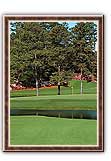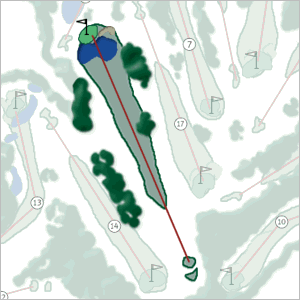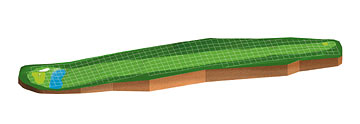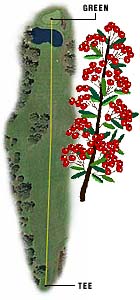| Hole Names | |
|
|
|

Hole #15FirethornPyracantha koidzumii Par 5, 500 Yards |

|
||
|
A reachable par 5 when winds are favorable, many golfers will attempt to reach the green in two. A well hit second shot must be made over the pond and away from the bunker that guards the green on the right. Gene Sarazen hit "the shot heard 'round the world" when he scored a double eagle in 1935. Mounds on right side of fairway have been flattened and now hold 20 pine trees, which could severely penalize any errant tee shot. Slight mound on the right of the green has been removed and six pine trees planted. Still can be reached in two, but second shot is over a pond. A cluster of pines trees replaced mounds on the right that put a greater premium on accuracy and makes the hole play longer. Still reachable in two, but pond guards the front and any approach must avoid bunker on the right. The hole on which Gene Sarazen made his famous double-eagle in 1935. The landing area for the tee shot has been modified over the years and now presents one large mound and several smaller ones, reducing the width to only 30 yards. The tee remains close to where it began, slightly to the right of the original. | |||

QuickTime AVI (4.07M) Animated GIF | |||
|
Jack Nicklaus says: Here again, hit it is as hard as you can, trying to miss the mounds on the right and the trees on the left. You have to hit it long enough to play an iron that will be accepted into the green. If you're standing back there with a 3-wood, it's like playing to the hood of a car. It's a difficult pitch if you lay-up short of the water, and it's an even more difficult pitch from over the green. It's a par-5 that most of the fellows will make a lot of 4s on, but you've got to be a little careful. The eagle I made here in 1986 was a special moment in what I consider my most memorable Masters victory. Despite what I did on the other holes, I really believed that to win the Masters that day I needed to eagle the 15th. I hit a good drive into a slight breeze, leaving 202 yards to the hole. My son, Jackie, was my caddie that week, and I remember turning to him and asking, “How far do you think a 3 on this hole would go here?” I had a 4-iron in my hand, but I wasn’t talking about changing clubs. I was referring to the score. Jackie answered, “A long way.” The shot never left the flag and landed just shy of the hole, stopping 12 feet away. Augusta National has eliminated the mounds right of the fairway and added several trees, so a long, straight tee shot is an absolute must if you want to make up some ground here. Another motivation for a good drive is that the third shot— a downhill pitch over water to an elevated green—is a very difficult shot. You want to get yourself to the green in two, even if you put it in the bunker right of the green. I always favor the right side of the green and prefer not to hit a draw unless I’m playing 3-iron or less. Fuzzy Zoeller says: This is a long-hitter's paradise. The rule here is, if you see water on your second shot, you go for it. There's two big pines on the left on your drive. If you hit it there, you're dead. The green slopes severely, but it's flat. Tiger Woods says: The longer hitters have a distinct advantage, because there are mounds on the right side about 280 out. Anyone who can hit it that far will land on the far side of the slope and release it down there to where you'll have a mid- or short-iron to the green. Traditionally it's been one of the hardest greens to hold. It's a very scary shot. Majority of the guys will bail right into the gallery or bunker and try to make 4 the hard way. Fred Couples says: Another hole where you just swing as hard as you can. You get down there and you're left with anything from a 2-iron to a 6-iron -- all depends on the weather or how hard the fairway is -- to a green that just sits there and it looks so easy. But if you come up short, obviously you go in the water and when you go over, it's probably a 3 out of 10 chance of getting it up and down. Another hole, where I've done well on and I've picked the wrong club for a second shot and knocked it over the green and made a lot of pars, which is hard when you feel like you're going to walk away with a birdie. It's a tough green to putt. Bernhard Langer says: This was a very significant hole when I won in 1993. I was playing with Chip Beck and he was really the only other person left in contention on Sunday. I didn't hit a great tee shot, so I had no choice but to lay up. Chip had about 240 yards to clear the water with the wind in his face, so he had a tough decision to make. He opted to lay up, then made his par. I made birdie and increased my lead to four shots. Many people criticized Chip for laying up, but he wouldn't have been in that position in the first place if he weren't a great player. It was a difficult decision and he was in a no-win situation. This year, the club has removed the mounds on the right side of the fairway and added trees in that area. Those changes will make the tee shot narrower and stop the long hitters from carrying the humps and getting a big kick off their far sides. The shortest club I've ever hit into the green on the second shot is a 4-iron, so when you hear about guys hitting 8- or 9-iron in, it shows you what an advantage they have. The green is only 15 yards deep on the left and 25 yards deep on the right, and very severe.
| |||

Hole #15FirethornPyracantha koidzumii Pyracantha coccinea is one of the most prolific bearers of orange/red berries. It belongs to the Rose Family and in April is covered with numerous small, creamy white flowers which in turn form the brilliant berries. The name Firethorn comes from the multitude of thorns which cover the branches. It is native to Southern Europe. |

|
||
fatpat Software · PO Box 1785 · Charlottesville, VA 22902 · (804) 977-1652
